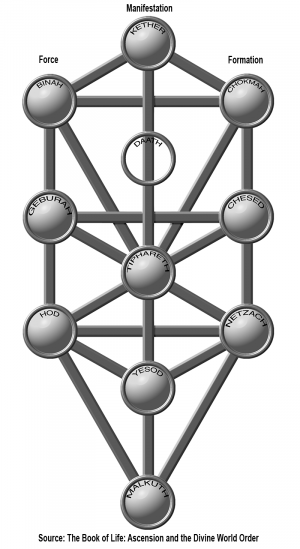Emanation: Difference between revisions
An Avatar.Global Resource
mNo edit summary |
m →Notes |
||
| Line 8: | Line 8: | ||
In the Cabballa, creation is represented as a staged emanation process. In this staged process of creation, intent passes through four “levels” on its way to the manifestation of the life-filled universe you see around you now. In Jewish Cabbala, the stages are named Kether (pure Consciousness) Tiphareth, Yesod, and finally Malkuth (physical universe). | In the Cabballa, creation is represented as a staged emanation process. In this staged process of creation, intent passes through four “levels” on its way to the manifestation of the life-filled universe you see around you now. In Jewish Cabbala, the stages are named Kether (pure Consciousness) Tiphareth, Yesod, and finally Malkuth (physical universe). | ||
The sanskrit word for emanation is saJcAra (सञ्चार), which implies emanation, passage, evolution, moving, and development, not necessarily without difficulty. Compare with saMskRti (संसृति) which emphasizes the passage through several states of existence/the course of mundane existence. | |||
=Further Reading= | =Further Reading= | ||
Revision as of 12:10, 14 June 2017
The Emanation of Creation is the process of the manifestation of Physical Creation from source Consciousness. A full accounting of the emanation of creation is provided in Michael Sharp's four volume Book of Light series.
Notes

There is a visual representation of this multilevel process of emanation in the Jewish Cabbala known as the Tree of Life. The Tree of Life is an ancient representation of how creation emanates from the mind of God (Sharp, BOLIFE).
In the Cabballa, creation is represented as a staged emanation process. In this staged process of creation, intent passes through four “levels” on its way to the manifestation of the life-filled universe you see around you now. In Jewish Cabbala, the stages are named Kether (pure Consciousness) Tiphareth, Yesod, and finally Malkuth (physical universe).
The sanskrit word for emanation is saJcAra (सञ्चार), which implies emanation, passage, evolution, moving, and development, not necessarily without difficulty. Compare with saMskRti (संसृति) which emphasizes the passage through several states of existence/the course of mundane existence.
